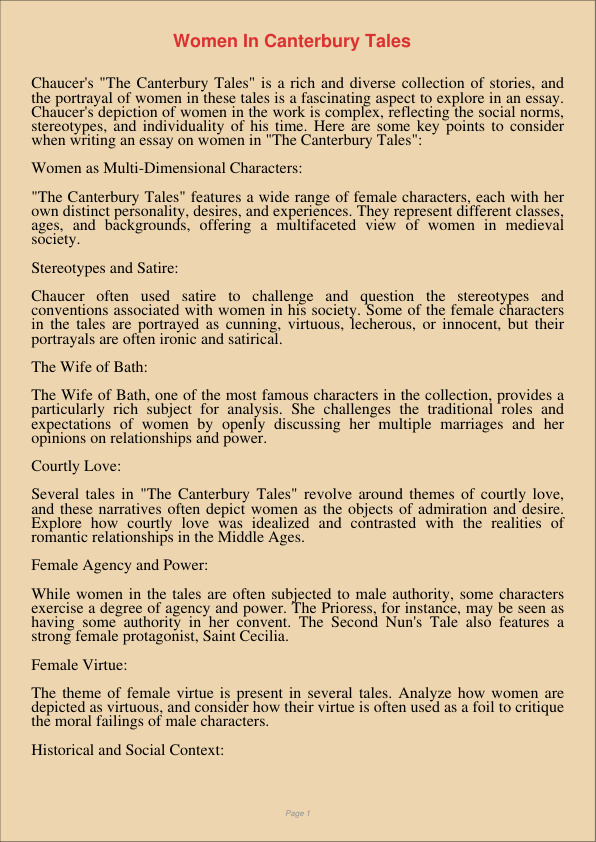
Chaucer’s “The Canterbury Tales” is a rich and diverse collection of stories, and the portrayal of women in these tales is a fascinating aspect to explore in an essay. Chaucer’s depiction of women in the work is complex, reflecting the social norms, stereotypes, and individuality of his time. Here are some key points to consider when writing an essay on women in “The Canterbury Tales”:
Women as Multi-Dimensional Characters:
“The Canterbury Tales” features a wide range of female characters, each with her own distinct personality, desires, and experiences. They represent different classes, ages, and backgrounds, offering a multifaceted view of women in medieval society.
Stereotypes and Satire:
Chaucer often used satire to challenge and question the stereotypes and conventions associated with women in his society. Some of the female characters in the tales are portrayed as cunning, virtuous, lecherous, or innocent, but their portrayals are often ironic and satirical.
The Wife of Bath:
The Wife of Bath, one of the most famous characters in the collection, provides a particularly rich subject for analysis. She challenges the traditional roles and expectations of women by openly discussing her multiple marriages and her opinions on relationships and power.
Courtly Love:
Several tales in “The Canterbury Tales” revolve around themes of courtly love, and these narratives often depict women as the objects of admiration and desire. Explore how courtly love was idealized and contrasted with the realities of romantic relationships in the Middle Ages.
Female Agency and Power:
While women in the tales are often subjected to male authority, some characters exercise a degree of agency and power. The Prioress, for instance, may be seen as having some authority in her convent. The Second Nun’s Tale also features a strong female protagonist, Saint Cecilia.
Female Virtue:
The theme of female virtue is present in several tales. Analyze how women are depicted as virtuous, and consider how their virtue is often used as a foil to critique the moral failings of male characters.
Historical and Social Context:
To fully understand the portrayal of women in “The Canterbury Tales,” it’s essential to consider the historical and social context of the 14th century. Discuss the roles and expectations of women in medieval England and how these influenced Chaucer’s narratives.
Interactions with Male Characters:
Examine the interactions between female and male characters in the tales. How do these interactions reveal power dynamics, social norms, and attitudes towards women in Chaucer’s time?
Feminist Interpretations:
Some readers and scholars have applied feminist interpretations to “The Canterbury Tales.” Discuss how modern feminist perspectives can shed light on Chaucer’s portrayal of women, their agency, and their challenges.
Modern Relevance:
Conclude your essay by considering the modern relevance of Chaucer’s depiction of women. How do the themes and characterizations in “The Canterbury Tales” relate to contemporary discussions about gender, feminism, and literature?
In your essay, you can choose specific tales and characters to analyze and draw connections to the broader themes and societal norms of the time. Chaucer’s treatment of women in “The Canterbury Tales” offers a nuanced lens through which to explore the complexities of gender and relationships in medieval society.
「真诚赞赏,手留余香」
真诚赞赏,手留余香
使用微信扫描二维码完成支付
